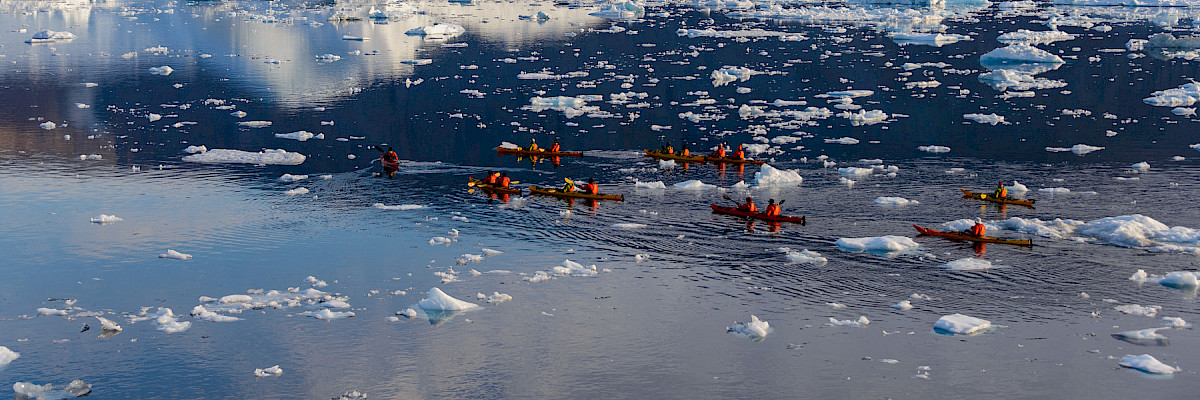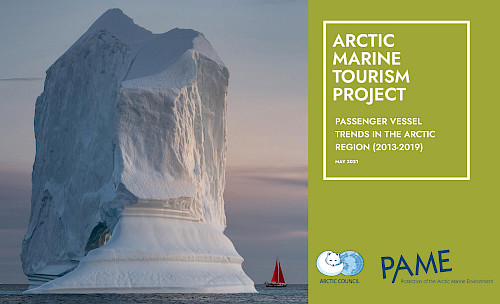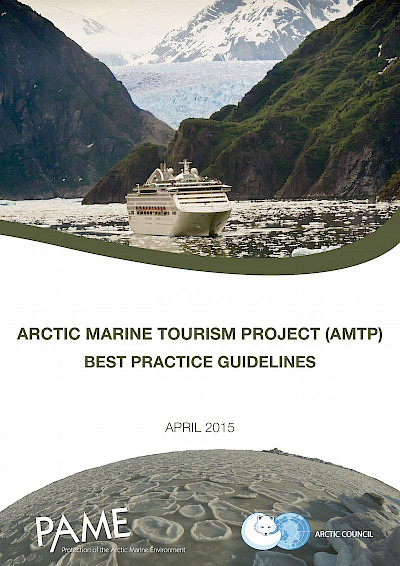
Arctic Marine Tourism
 PAME's Arctic Marine Shipping Assessment (2009) spoke extensively on marine -based tourism in the Arctic. In recognition of the wide-ranging management challenges associated with the growth of tourism in the region, PAME initiated a follow-up project in 2013 attempted to identify issues or gaps where the Arctic Council could add value and culminated in the creation of a range of voluntary best practice guidelines encouraging action by the Arctic Council, Arctic States, or collaboration between the two.
PAME's Arctic Marine Shipping Assessment (2009) spoke extensively on marine -based tourism in the Arctic. In recognition of the wide-ranging management challenges associated with the growth of tourism in the region, PAME initiated a follow-up project in 2013 attempted to identify issues or gaps where the Arctic Council could add value and culminated in the creation of a range of voluntary best practice guidelines encouraging action by the Arctic Council, Arctic States, or collaboration between the two.
The result were the 2015 Arctic Marine Tourism: Best Practice Guidelines, a voluntary document encouraging action on behalf of the Arctic Council, Arctic States, and in some instances collaboration between the two, and is meant to strengthen, not preclude, the range of existing mandatory requirements and voluntary policies and guidance currently in place to support sustainable Arctic marine tourism issued by levels of government, industry, industry associations and the NGO community.
The 2015 Guidelines included several recommendation, of which PAME followed up with in a new project in 2019; The Arctic Marine Tourism Project: Passenger Vessel Trends in the Arctic Region (2013-2019) (AMTP 2021).
The project comprised of two work packages:
- Work Package 1 (WP1): Compilation and analysis of data on tourism vessels in the Arctic using PAME's Arctic Ship Traffic Database (ASTD) to better understand recent developments.
- Work Package 2 (WP2): Summary of existing site-specific guidelines for near-shore and coastal areas of the Arctic visited by passengers of marine tourism vessels and pleasure craft
The project report includes the analysis, made by the British Antarctic Survey and further analysed by the PAME Secretariat, graphics, maps and other information, also available below in the project repository.
The report also includes a standardized template that could be used for the development of site-specific guidelines aimed at tourists/vessel operators, and tailored towards, inter alia, mitigating safety and environmental risks, encouraging sustainable use, and educating visitors on ecological, cultural, and historical features unique to particular areas. An explanation of the methodology used and the step-by-step approach to be employed is also included. This was done in close collaboration with the Association of Arctic Expedition Cruise Operators (AECO).
There are multiple ways to frame levels of ship activity within a given geographic area. One common methodology is to tabulate the number of unique or individual ships operating within a specific area - referred to as unique ship count. This method counts each ship only once, regardless of whether there are multiple entries and exits within a preset polygon. From 2013-2019 there has been a gradual increase in the number of individual passenger vessels operating within the Arctic as defined by the Polar Code. The total increase from 2013 to 2019 is 35%.

 2021 Tourism Project Workshop
2021 Tourism Project Workshop
In 2020, the project co-leads convened a face to face workshop to advance the project.
Presentations:
- ASTD: Tourism vessels in the Arctic (Hjalti Hreinsson - PAME Secretariat)
- Marine Domain Awareness - Arctic Canada (Dominique Jolicoeur - Transport Canada)
- AECO Cruise Database (Troels Jacobsen)
- AECO's Site Specific Guidelines (Edda Falk)
- Cruise tourism in Iceland (Elías Bj. Gíslason - Icelandic Tourist Board)
2015: Arctic Marine Tourism Project (AMTP)
From 2013-2015, PAME developed the 2015 predecessor of the 2021 report.
PAME organized workshops to identify issues or gaps where the Arctic Council can add value by articulating best practices in relation to vessel-based Arctic tourism.
The result of this project is a best practices document that:
- avoids duplication by being aware of existing guidelines and best practices
- identifies existing best practices while also determining any practical problem areas or actual issues requiring some resolution
- takes into account regional variations, categories of tourist/vessel operations, various stakeholder perspectives, and practical us ability of a best practices document; and
- considers the intended audience(s) for development of best practices.
The final report was released in 2015 and introduced at the Arctic Council ministerial meeting in April.
The final report was released in 2015 and introduced at the Arctic Council ministerial meeting in April.
In the context of the AMTP ‘Arctic marine tourism’ is understood to include activities or interactions that are in some way facilitated by (though not limited to) the operation of a vessel in Arctic waters. While a convenient shorthand, it is recognized that the term does simplify an otherwise diverse industry and range of activities that reflect many regional and geographical variations.
Accordingly, unless otherwise specified, the best practice guidelines that follow are intended for broad application and not necessarily exclusive to vessel operators, but rather the coastal administrations and local communities directly involved in aspects of Arctic marine tourism as well. ‘Sustainable Arctic tourism’ is given the same definition used by the Arctic Council’s Sustainable Development Working Group (SDWG) in the Sustainable Model for Arctic Regional Tourism (SMART) Report to mean “tourism that minimizes negative impacts and maximizes socio-cultural, environmental and economic benefits for residents of the Arctic”.
The AMTP best practice guidelines is a voluntary document encouraging action on behalf of the Arctic Council, Arctic States, and in some instances collaboration between the two, and is meant to strengthen, not preclude, the range of existing mandatory requirements and voluntary policies and guidance currently in place to support sustainable Arctic marine tourism issued by levels of government, industry, industry associations and the NGO community.
Click here to download the report.
The project gratefully acknowledges funding from the Nordic Council of Ministers.
Lead Working Groups
PAMELead Arctic States & Permanent Participants
CanadaIceland
 Arctic Council Working Group
Arctic Council Working Group 